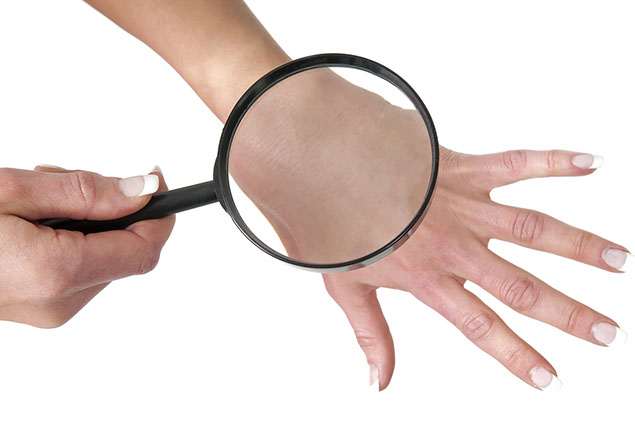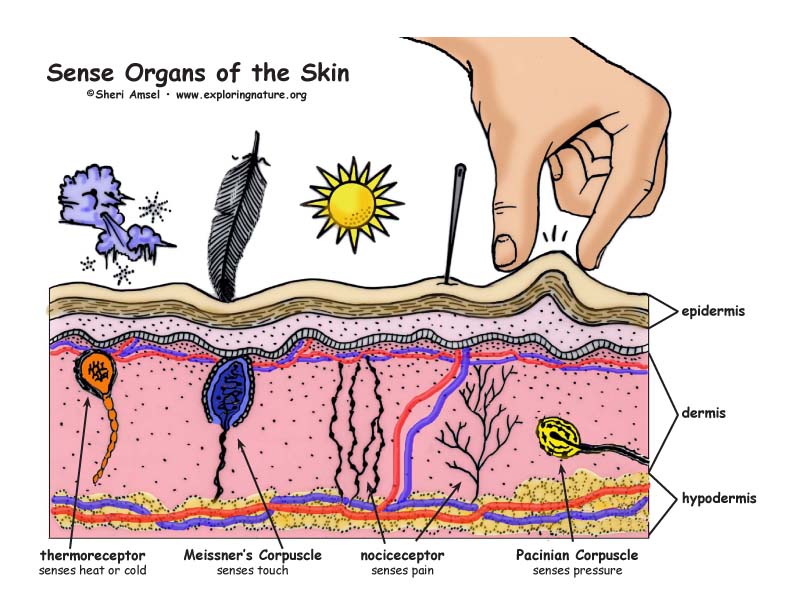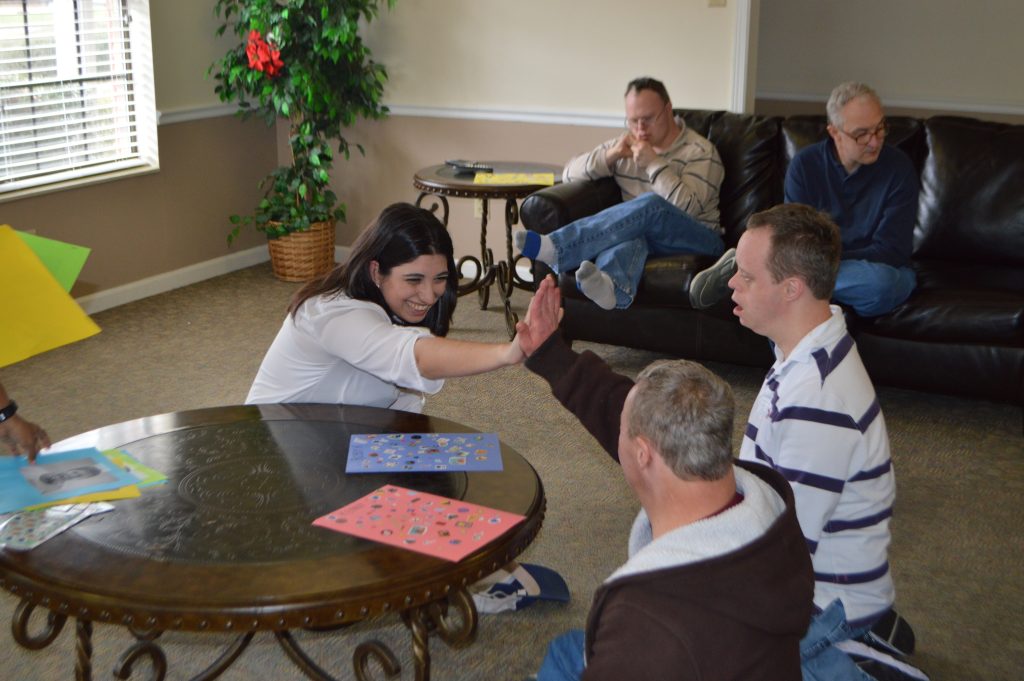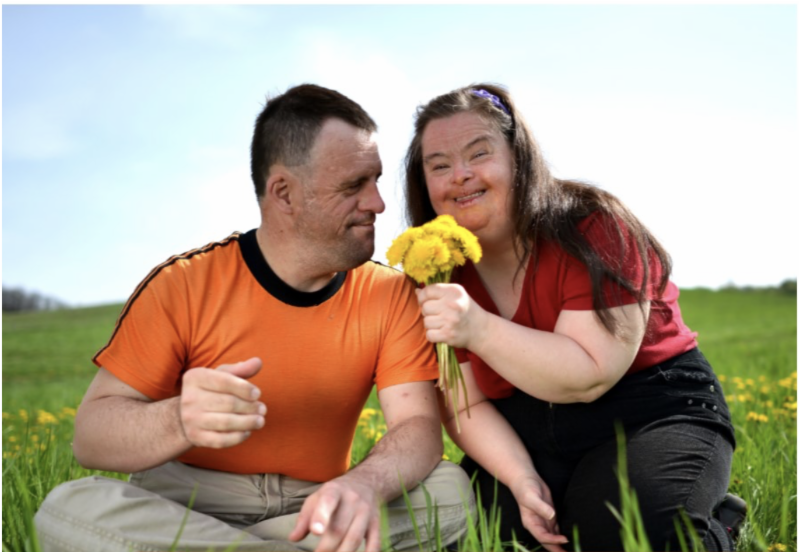
“Our sense of touch allows us to receive information about our internal and external environments, making it important for sensory perception.
The first sense to develop in a human fetus is touch. At 8 weeks, a fetus responds to touch of the lips and cheeks, with other body parts responding by 14 weeks. Infants use touch to learn about the world around them and to bond with others – positive touch assists an infant’s healthy development.”
“The touch sense responds to anything that touches the skin. The skin is a very clever organ. It responds to much more than touch.” [3]

“The skin – The skin is the largest organ in the human body. It does more than just process touch. It receives information about the following sensations.
Touch – There are three different types of touch light touch, discriminative touch and touch pressure. I explain them all below as it’s important you know the differences between them.
Pain – The body has a fast and slow pain response. The fast is protective, it’s what moves your body out of danger. The slower one sticks around for a while and reminds you that you were injured.
Temperature – This tells you brain if the environment temperature is hot or cold. Goosebumps are an old reflex to cold which makes the hair stand up. When we had more hair on our bodies, this would have increased the insulation our hair provided to our body.
Vibration – The skin also processes vibration. This is not something we would feel very frequently but the receptors are still there.” [3]

“Throughout one’s life, there are many positive outcomes that derive from being touched.” [2]
“Some of the medical, physiological, and psychological effects derived from touching behavior include:
- Just under the skin are pressure receptors called Pacinian Corpuscles that signal the vagus nerve in the brain. This nerve can slow the heart and decrease blood pressure (Gueguen, 2004).
- Various cortices in the brain release hormones when the person is being touched (Field, 2010). Cortisol reduces stress (Jones & Glover, 2014) and oxytocin can improve interpersonal relationships because the person feels close to and trusting of another.
- Touch, as in hugging, can boost the immune system as well as reduce pain and aid in sleeping.
- Touching is a basic experience of our body and helps us develop a sense of self (Gillmeister, et al., 2017).” [2]

“Touching is as important as being touched. Engaging in touch:
- Improves muscle development and motor functioning.
- Is a means of expressing one’s emotions..
- Assists in learning about and navigating essential constructs (i.e., understanding weight, temperature, texture); thus, increasing cognitive development.” [2]
“Touching is also one of the hallmarks of social interactions.
Touching promotes attachment and relational security to others (Beltran, et al., 2020).” [2]

Variables that affect touching behavior
“As one moves into late adulthood, there may be fewer opportunities to have “tactile experiences”.
It should be recognized, however, that the power of social touch is not uniform across gender, culture, and age (Gallance & Spence, 2010).
There are also people who experience distress when being touched or touching others. The experience of touch can also be harmful when it is unwanted, physically hurtful, or exploitive. Unfortunately, experiencing such events can have serious ramifications for the individual at any age as well as interfere with one’s ability to benefit from appropriate touching.” [2]

Teaching Social Boundaries to Adults with IDD
“It’s critical to teach your loved one with IDD social boundaries and personal space. These “rules of the road” center around instilling good people skills while actively using thoughtfulness toward others.
You can role play and illustrate different wrong ways to interact followed by the correct ways to interact with people. This simple but impactful activity can be a basic foundation in social manners that can be reinforced by other activities, games, etc.” [4]

- “Teach What Makes a Good Friend: It’s helpful to teach adults with IDD that friendships are relationships you need to continually work on. or can role play different scenarios that demonstrate ways you can show a friend you care, such as: Bringing a friend a flower on their birthday; Asking them about their day; etc. At the same time, you can show them what happens if you’re not nice to your friend and the ways it can negatively affect the relationships. One strategy is to view videos of dishonesty, or other bad friend behavior and the ensuing negative consequence. [4]

- “Social Boundaries: In any case, touching others and physical contact is only appropriate when both people choose to be touched. Make sure to explain if they feel a touch isn’t appropriate at any point in time, they should always talk to a trusted adult.” [4]
- “Teaching Healthy Relationships and Sexual Behavior: People with IDD have emotional needs and sexual feelings. While this conversation can be embarrassing or awkward, it’s critical to acknowledge these natural feelings and thoughts. By teaching social and sexual boundaries to adults with IDD, you can help them be safe, healthy and respectful to others. Most importantly, it’s vital to educate them on which behaviors are appropriate.” [4]

“We need to teach individuals with disabilities how to be safe around other people, and how to keep themselves safe within society, while also leaving room for them to be the unique individual they were created to be.” [5]
Resources:
[1] https://www.sciencelearn.org.nz/resources/1892-touch
[2] https://www.psychologytoday.com/us/blog/emotional-nourishment/202108/the-importance-touch
[3] https://www.griffinot.com/touch-sense-sensory-processing/
[4] https://communitymainstreaming.org/teaching-social-boundaries-to-adults
[5] https://blog.giv.care/teaching-boundaries-to-adults-with-developmental-disabilities/
